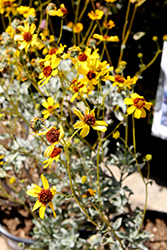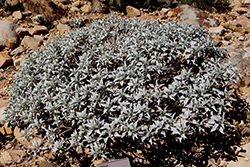It's all about ...
plants

Height: 4 feet
Spread: 4 feet
Sunlight:
![]()
Hardiness Zone: 8b
Other Names: Bush Sunflower
Description:
A fast growing, bushy shrub with many thin branches and widely spaced leaves; yellow, daisy-like flowers cover the plant from mid winter to late spring and attract pollinators; beautiful in winter and spring but will go dormant in summer heat
Ornamental Features
Brittlebush features airy lightly-scented yellow daisy flowers with brick red eyes held atop the branches from mid winter to late spring. The flowers are excellent for cutting. It has grayish green foliage with hints of silver. The pointy leaves do not develop any appreciable fall colour.
Landscape Attributes
Brittlebush is a multi-stemmed deciduous shrub with a more or less rounded form. Its average texture blends into the landscape, but can be balanced by one or two finer or coarser trees or shrubs for an effective composition.
This is a relatively low maintenance shrub, and should only be pruned after flowering to avoid removing any of the current season's flowers. It is a good choice for attracting bees and butterflies to your yard. Gardeners should be aware of the following characteristic(s) that may warrant special consideration;
- Spreading
- Self-Seeding
Brittlebush is recommended for the following landscape applications;
- Mass Planting
- Hedges/Screening
- Groundcover
- Naturalizing And Woodland Gardens
Planting & Growing
Brittlebush will grow to be about 4 feet tall at maturity, with a spread of 4 feet. It has a low canopy with a typical clearance of 1 foot from the ground. It grows at a fast rate, and under ideal conditions can be expected to live for approximately 10 years. As this plant tends to go dormant in summer, it is best interplanted with late-season bloomers to hide the dying foliage.
This shrub should only be grown in full sunlight. It is very adaptable to both dry and moist growing conditions, but will not tolerate any standing water. It is considered to be drought-tolerant, and thus makes an ideal choice for xeriscaping or the moisture-conserving landscape. It is not particular as to soil pH, but grows best in poor soils. It is somewhat tolerant of urban pollution. This species is native to parts of North America.
This plant is not reliably hardy in our region, and certain restrictions may apply; contact the store for more information.

